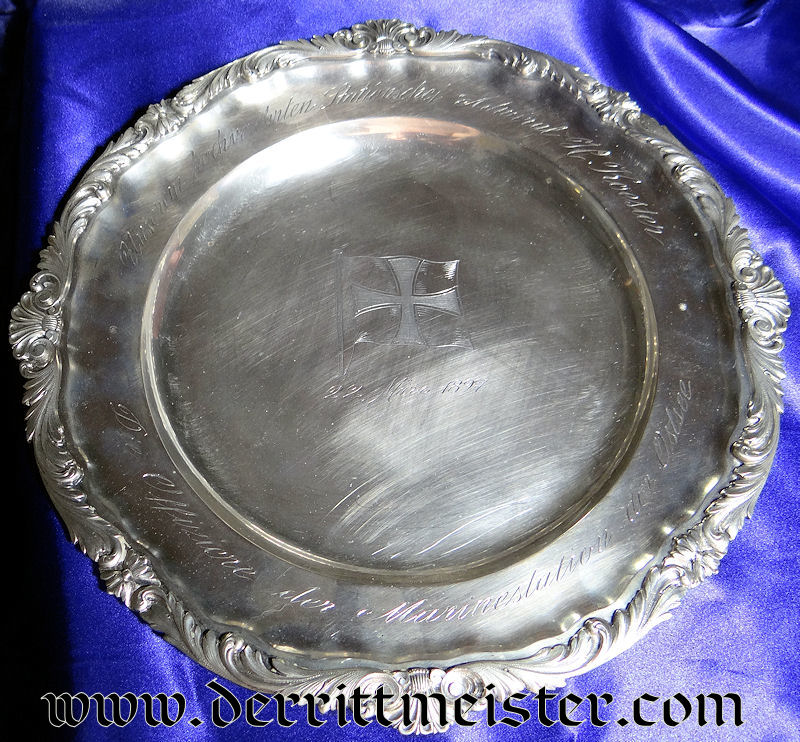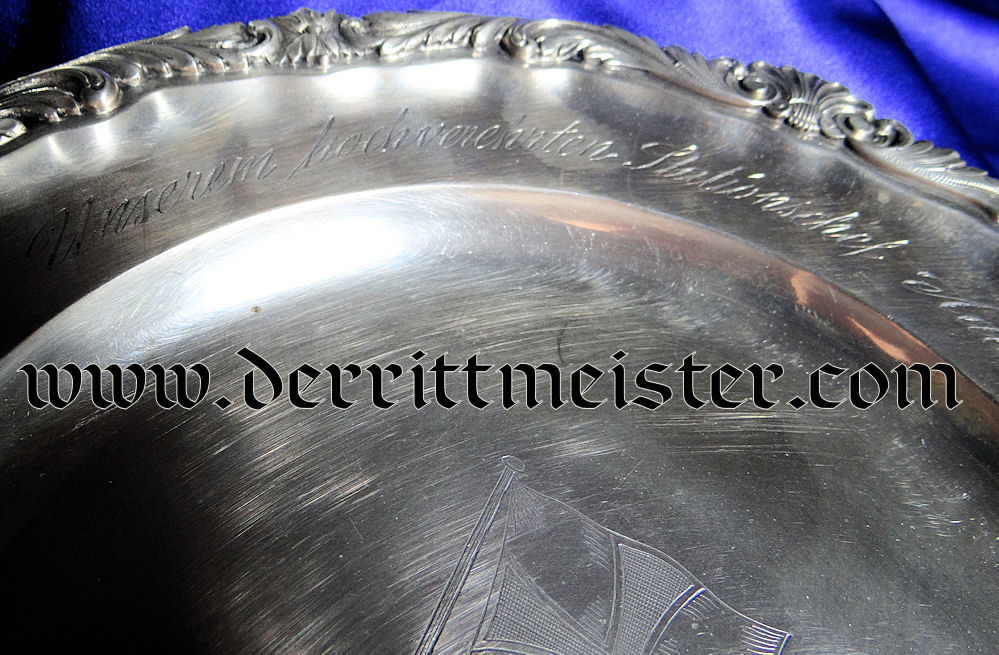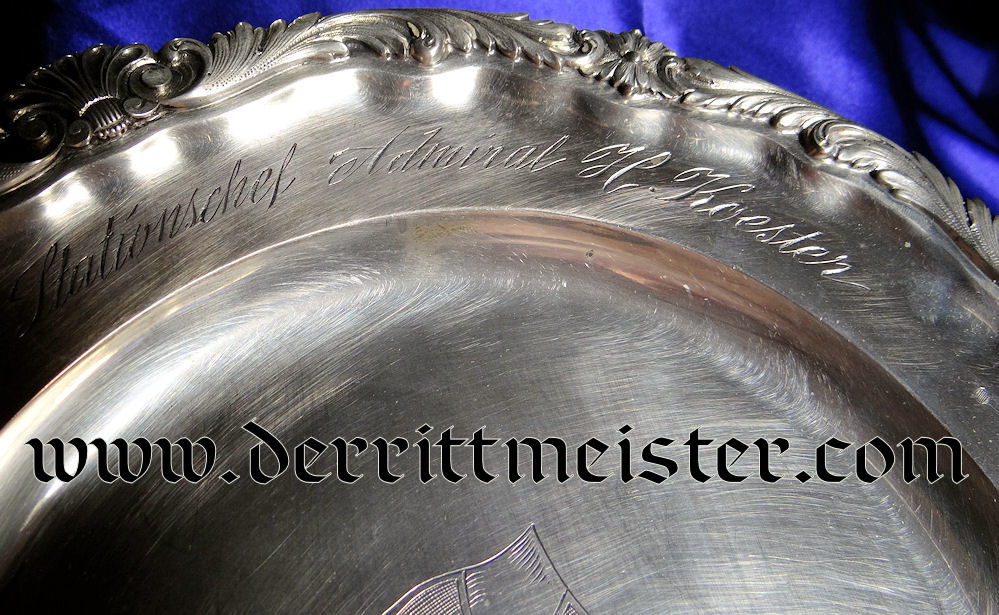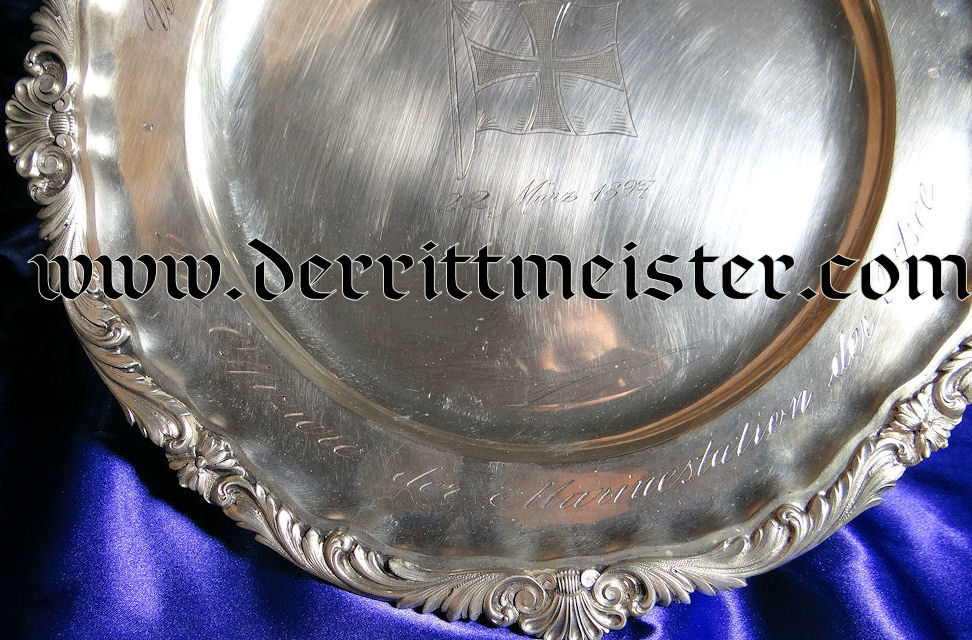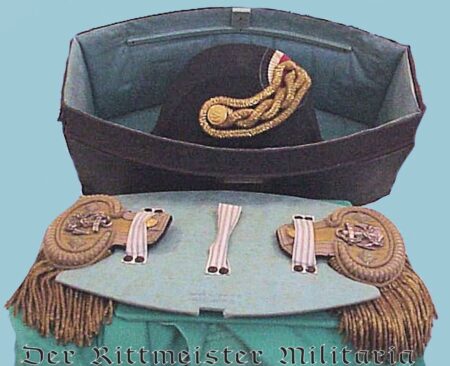Description
I first offered this group over a decade ago. The fellow who has owned it since then recently changed his area of interest, so I was thrilled to take it back in trade. (Items like this just do NOT become available often). Hans von Koester was one of six Imperial Period men (five Germans and one Swede) appointed as a Großadmiral. The rank was created in 1901, with Kaiser Wilhelm II (naturally) appointing himself the first rank holder. King Oskar II of Sweden was granted the same rank that year as a ceremonial gesture. Listed below are the six men who held the rank from 1901 until the empire’s end in 1918.
1901 – Kaiser Wilhelm II (1859–1941)
1901 – King Oskar II of Sweden (1829–1907)
28 June 1905 – Hans von Koester (1844–1928)
4 September 1909 – HRH Prinz Heinrich of Prussia (1862–1929)
27 January 1911 – Alfred von Tirpitz (1849–1930)*
[*Promoted on an Honorary Basis without Patent]
31 May 1918 – Henning von Holtzendorff (1853–1919)
The first two recipients were ceremonial appointments rather than direct commands. The third appointee, Hans von Koester, was the first “operational” admiral to receive the rank. He was promoted to Großadmiral in 1905 as a reward for his long service. He actually retired the following year (1906). The next to receive the rank was Prinz Heinrich, (one of whose tunics and officer’s summer schirmütze we are proud to offer). Heinrich held direct command in the Kaiserliche Marine and was a royal, so his appointment was not an à la Suite promotion. Heinrich was the second officer with a naval background to achieve the rank. Alfred von Tirpitz was the third.
*[PLEASE NOTE: von Tirpitz’s promotion must be viewed with an “asterisk.” His promotion was WITHOUT patent. That is, he was a Großadmiral in title, but his rank was more like that of an à la Suite (an honorary appointment for royalty ONLY). This somewhat confusing situation was evident on two different von Tirpitz shoulder boards we have offered in the past. Instead of a Großadmiral’s crossed batons, those boards displayed FOUR pips, which indicated the equivalent of a Generaloberst in the rank of Generalfeldmarschall. The latter was a rank often used by royals in the Imperial German Army, and officially WAS an à la Suite position. Prior to the institution of Großadmiral, the Imperial German Navy’s highest rank was a full Admiral, who wore TWO pips. The Navy had no equivalent to the Imperial German Army’s Generaloberst, who displayed THREE pips. The Navy simply skipped the rank! The number of shoulder board pips displayed on the four admirals’ ranks was as follows: a Konteradmiral wore NO pips; a Vizeadmiral displayed ONE pip; an Admiral boasted TWO pips; and a Großadmiral had NO pips, but instead displayed crossed batons].
The final man to achieve the rank was Henning von Holtzendorff. He assumed Alfred von Tirpitz’s role, and also did not exercise direct command after his promotion. In fact, he retired before the war’s end due to health problems (he died in 1919). Von Holtzendorff was replaced by Admiral Reinhard Scheer (the High Seas Fleet commander at 1916’s Battle of Jutland/Skagerrak). Scheer was responsible for running the Navy, but was NOT awarded a Großadmiral’s rank. The following small group of Großadmiral Hans von Koester’s personal effects is absolutely marvelous.
PAIR OF GROßADMIRAL’S EPAULETTES. I have seen some superb shoulder boards and epaulettes over the years, including those from the Kaiser. Nothing, however, has ever touched the sublime beauty of these truly magnificent specimens. Their centers are made of gold silk! Wool or felt is normally used for background material, not silk. Each center is highlighted by a pair of crossed batons. The batons’ artistry sets them apart from any Army Generalfeldmarschall’s batons. Army batons usually are made of silver, rather than the exquisite enamel used by the Navy. These display four different colors: gold, white, red, and black. Neither epaulette displays any damage whatsoever to these magnificent batons. A massive silver eagle grasping a fouled anchor in its claws overlays each baton set. Just below a small gilt naval button on the epaulette’s tongue is a silver Kaiser Crown. The tongue also displays red and black piping on a white background. The use of red, black, and white (the national colors) indicates that the Kaiserliche Marine was under the Reich’s authority, not the Kingdom of Prussia’s.
More gold design work extends out from the silk field on which the batons and eagles are mounted. Massive gold ringlets flow down majestically around their edges. (They must have looked amazing when worn on the dress uniform)! The epaulettes’ undersides are covered in navy-blue wool, another sure sign that they are correct for the Kaiserliche Marine. A sliding brass clip arrangement allows them to be slipped onto the tunic.
Looking at these epaulettes and their superb condition, one would be hard pressed to believe they are more than one-hundred-years-old.
GROßADMIRAL’S UNIFORM CUFFS. Imperial German Navy Admiräle uniforms displayed gold bullion stripes that indicated the man’s rank. Daily-use tunics did NOT display shoulder boards, so rank was determined by the number of stripes on the cuffs. In a Großadmiral’s case, FOUR stripes designated his rank. Each of these stripes measures 9/16″ in width. In addition to the rank stripes, a single wide band of gold bullion is present that measures 1 15/16″ in width. Its bullion displays a wonderful patina, with gentle toning. Each cuff normally had a bullion Kaiser Crown attached, as well. Only one of them is present, and is NOT attached to the cuff. [We will show this in our photographs]. Each cuff is wrapped very neatly in some very old tissue paper. Both are most attractive.
FORE & AFT CAP (ZWEISPITZ) BELONGING TO ADMIRAL HANS von KOESTER. Naval officers wore two types of headdresses. First, for regular duty, was the schirmütze (visor cap). Second, for more formal occasions, and often worn with a Gala Naval Uniform, was the zweispitz (fore and aft cap). [Naval officers actually had three types of uniforms: daily wear, dress, and high-dress (Gala). Many officers did not even have a Gala uniform unless they were of higher rank or were extremely wealthy]. In the USA, we more frequently associate fore and aft caps with naval headdresses from the 18th and early 19th Centuries. In the Kaiserliche Marine, an Admiral’s zweispitz was different from the other officers’ headdresses. Von Koester’s zweispitz is significantly and magnificently more elaborate.
The zweispitz’s body is covered with close-cropped very fine fur, perhaps seal. In addition to the golden coil that extends from the gilt navy button on the cap’s right side, the other huge difference is a 2 ½”bullion band that runs the length of the cap’s two sides. Each of the cap’s ends sports multiple silver bullion ringlets. Beneath the top row of silver ringlets is another row that is interspersed with silver, red, and black ringlets. The cap’s right side boasts a large and very elegant silk Reich’s kokarde.
Turning to the interior, we see a very high-quality, light-brown leather sweatband. It is 100% complete and in excellent condition. If we look closely, in a place or two we can see some very slight sweat stains from where von Koester actually wore it! The white silk liner is flawless and in superb condition. His name, “von Koester,” is embossed in gold on the white silk liner.
STORAGE CASE FOR ALL ITEMS LISTED ABOVE. This is a large storage case that measures 8 1/4″ x 9″ x 18.” The case was used to store the epaulettes and zweispitz when not in use. It has a handle on the top that made it convenient for use when traveling. On the case’s front is a small plaque that measures 1 3/16″ x 3 ½” and bears his name: “von Koester.” When I originally bought the group many years ago, the case’s top half was separated from its bottom half. The hinges and screws that secured them had pulled loose. When I bought the group back, I decided to address the problem. Normally, I prefer to avoid restoration, but in this case I felt it was in order. So we inserted new screws in the original hinges and the case operates as it did more than one-hundred-years ago. The original key is attached to the handle!
Inside the case we see that the zweispitz is nestled at the bottom. Over it is a red silk platform. The platform performs two purposes. It separates the zweispitz from the contents at the case’s top. That is where the platform becomes the epaulettes’ storage stand. Each epaulette slides onto the platform and is secured. The tunic cuffs are folded in their tissue and laid at the top, which makes for a tidy package.
SILVER PRESENTATION PLATE FROM von KOESTER’S STAFF WHEN COMMANDER OF DER MARINE STATION den OSTSEE. This is an ultra-high-quality silver presentation plate. It measures 11″ in diameter. The plate’s edges display very elaborate scrollwork accented with a floral motif. The following dedication is engraved at the plate’s top: “Unserem Hochverehrten Stationschef Admiral H. Koester” (Our esteemed station-chief Admiral H. Koester). Another engraving is presented at the plate’s bottom: “Die Offiziere der Marinestation der Ostsee” (The officers of the Baltic Sea Marine Station). An admiral’s flag is in the plate’s center. Below that is the presentation’s date, 22 März 1897. The plate’s reverse is highly tarnished and bears the manufacturer’s hallmark, as well as one for .800 silver, and the initials “AP.”
The Marinestation Ostsee was the Baltic Sea Naval Station located in Kiel. Von Koester held this post from 1889 to 1903. It should also be noted that he is recognized as an Admiral, rather than the lower rank of Vizeadmiral. It is interesting to note that von Koester received the promotion in 1897, the same year as the plate! The plate is in amazing condition for its age.
COLOR POSTCARD AND DETAILED HISTORICAL INFORMATION OF HANS von KOESTER. We are including a period color postcard of Großadmiral Hans von Koester. We thought it important that you know what the man looked like. We also have some historical background on him that chronicles his long career.
Words cannot adequately describe the beauty, rarity, and historical importance of this group. If you are a collector of Kaiserliche Marine items, we have many other important items including Prinz Heinrich’s aforementioned group, an overcoat with shoulder boards for a Großadmiral, and numerous epaulettes for every officer rank up-to-and-including a Kapitän zur See. (Please browse our “NAVY” Merchandise Page to see them, click here to see).














